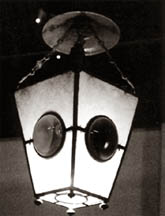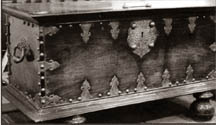|
observer |
|
|
|
|
|
OTHER LINKS |

|

|

|
Facets of life in the Dutch Period
Colonialism is often thought of as a dirty word these days with its insinuations of repression and exploitation. Why, then, would the idea of a museum to commemorate a time of foreign domination be so popular that it persisted for over a century with the support not only of different people, but even different generations? The answer can be found in the Dutch Period Museum in the form of its own history. The story it tells and the exhibits it showcases combine to pay testament to the lasting influence of 140 years of Dutch occupation. The path to the establishment of the museum was long, and many obstacles had to be overcome by determination, persistence and, finally, even by nature. The first advocate of the museum spoke out in the 1970s, but it wasn't until a century later that a beautiful Dutch building was identified as a potential premises. Originally the residence of the Dutch Governor, Thomas Ryke, the structure had served as an orphanage, a military hospital, a store for arms, a police training institute and finally as a post office. With the postal authorities refusing to relinquish the building, though, the future of the project looked bleak. It was on a stormy January night in 1974 that nature intervened by ripping down the east wall, leaving dangerous electrical cables exposed. Rather than invest in renovations, the postal authorities quickly departed, at last allowing the former governor's residence to fulfil its destiny as the Dutch Period Museum. Today, much has changed around the sturdy residency, so that locating it now involves twisting and turning through the narrow bustling streets of Pettah, Colombo's busiest trading area. Tumbling out of my steaming three-wheeler, I was immediately shunted off the road by a speeding fish cart propelled by a sarong-clad man, his dark back glistening with sweat in the afternoon sun.
The Dutch occupied Sri Lanka from 1656 to 1796, providing a buffer between the Portuguese and the British periods of occupation. In fact, what the Dutch actually occupied was only the coastal areas. Even today, Sri Lanka's littoral is dotted with architecture reminiscent of the Dutch - the high terracot a-tiled roofs and large airy rooms perfect for seaside living. The museum itself is a beautiful example of this style, featuring huge wooden beams, shuttered windows and stable-like doors. The highlight is the perfectly manicured grassy courtyard-the only example left in Colombo today-complete with wooden balcony where visitors can observe all the happenings on the lawn from beneath the cooling roof of the main house. The exhibits take the visitor on a journey through the Dutch occupation from early arrivals to the final demand by the British to leave. Immediately on entering, a 3-D painting draws the visitor into a king's court, awaiting an audience alongside the first Dutch envoys. Next, the focus shifts to the objectives of the Dutch, who as the dominance of the Dutch East India Company (VOC) shows, were driven by the quest for profit. Dominance of the lucrative spice trade was their main aim. While such a focus may have led to exploitation, it also had its advantages. Not only did it introduce the concept of the market economy to a nation of self-sufficient farmers, but its concentration on the economy meant that social and religious aspects of daily life were generally left untouched.
It was on taking this glimpse into the past that I really felt I was noosing round a Dutch governor's home! Faced with the mannequins in traditional costume, though, I was suddenly thankful it was the 21st century and that I didn't have to be strapped into the stiffling bodice I saw before me on this humid afternoon. Before climbing the stairs, I bravely entered "The Hall of Death", which I was relieved to find only contained Dutch period tombstones. Despite being a little morbid, reading the inscriptions gave a personal insight into people who lived and died during that era. Each stone features the skull and crossbones and even gives the length of life in days of the person commemorated-as if every moment counted. After ascending the wooden staircase, with its charming creaks and well-worn steps, I arrived at the second floor, which features an array of furniture made from jak, ebony, nedun and calamander wood among others. The most unusual piece is a palanquin, a portable chair that enabled servants to transport their masters on their shoulders. More common items include beds, tables, chairs, and almirahs all carved into striking pieces, whether ornamental or chaste; and of a similar style to many contemporary pieces. In fact, after exploring the building, gazing at the exhibits and reading the backgrounds, it is clear that many styles and aspects of life in that era continue to influence contemporary Sri Lanka. Specifically, current fashion in architecture and home decor borrows extensively from the Dutch period as demonstrated by a number of top-end hotels and wealthy homes. What arguably makes the Dutch contribution to Sri Lankan culture so lasting and visible is that it focused on areas such as the economy and architecture that didn't challenge traditional values. Consequently, the Dutch contribution has been valued over the years, leading to the establishment of the museum to pay tribute to it. Fitting, then, that it nestles in the heart of the trading hub of Colombo, for without the VOC who knows whether such a district would even exist. Lost in my reflections, I left the timeless atmosphere of the refined courtyard to return to the present day. Above all else, I now had a clearer understanding of where the Dutch fit into the tangled web of Sri Lankan history, and would now be seeing many aspects of contemporary life with greater insight-thanks to the museum. (Travelsrilanka) |

 It has to be said that many of Sri Lanka's museums are relics of a
bygone age, much like their exhibits. There are exceptions, however, in
particular Colombo's Dutch Period Museum, which, to give it an authentic
touch, is located in a magnificent 17th century Dutch Governor's
residence. Here can be seen many of the facets of life of the Dutch
period, some of which still have an influence today..........
It has to be said that many of Sri Lanka's museums are relics of a
bygone age, much like their exhibits. There are exceptions, however, in
particular Colombo's Dutch Period Museum, which, to give it an authentic
touch, is located in a magnificent 17th century Dutch Governor's
residence. Here can be seen many of the facets of life of the Dutch
period, some of which still have an influence today..........  Two three-wheelers, a car, and two vans growled their way past before
I dared cross the busy street to the eight striking pillars that
announce the entrance to the museum.
Two three-wheelers, a car, and two vans growled their way past before
I dared cross the busy street to the eight striking pillars that
announce the entrance to the museum.  Moving further into the museum, there are sections on every aspect of
life under the Dutch, showcasing coins, arms, intricately carved ivory
boxes, temple paintings and even a temple pillar. Without doubt, my
favourite exhibit was the almirah filled with household belongings,
accompanied by an explanation of each item.
Moving further into the museum, there are sections on every aspect of
life under the Dutch, showcasing coins, arms, intricately carved ivory
boxes, temple paintings and even a temple pillar. Without doubt, my
favourite exhibit was the almirah filled with household belongings,
accompanied by an explanation of each item. 







